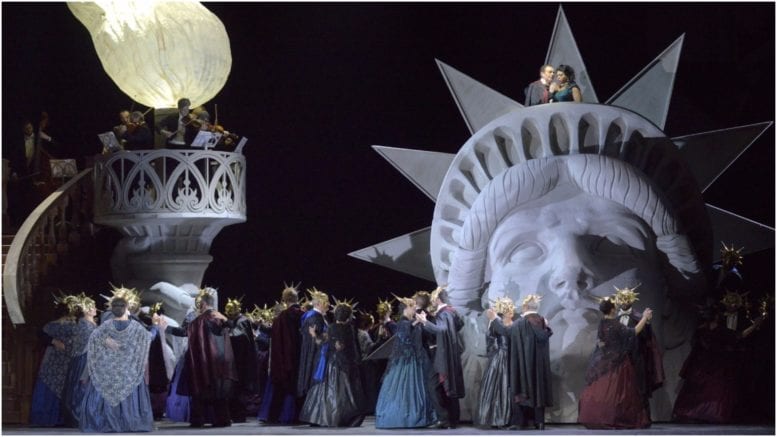Verdi’s opera had a tumultuous fate: Somma’s libretto after Scribe’s Gustave III was censored by the Naples authorities and consequently had three titles and three settings: Sweden (1792), Germany, and Boston, Massachussetts (late seventeenth century).
Aliverta’s recent La Fenice production places the action in Boston, but moves it to 1867-1887, “when the XIII amendment had already been approved so that slavery would be abolished forever”, he explains in the programme. Thus, the performance unexpectedly confronts the audience with the first wave of Ku Klux Klan activity, led by the Judge – a declared racist, as in the libretto he indicts the black magic practioner: “Ulrica – dell’immondo sangue de’ negri.”
However, Aliverta’s production conceives Amelia as “a person of colour”, which renders the whole plot extremely illogical. She has been married to Renato for a while, which is implausible because of the historical anti-miscegenation laws. However, if we accept this given, the Judge’s phrase becomes untenable, as he could hardly malign “the filthy negro blood” in front of Governor Riccardo, since his secretary, best friend and confidant is married to a woman of African blood who is obviously accepted in high society.
The whole staging brings into bold relief this incongruous American reality. In Act I, a black man washes the stairs and is kicked by an official. Oscar is poor and socially inferior, apparently inspired by Oliver Twist, in order to reveal Riccardo’s generosity and open-mindedness. On the other hand, a huge American flag decorates the governor’s hall, and the same flag will be plucked down by a black follower of Ulrica’s. In exchange, all the white men in Act I have American colours scarves – a childish detail, especially since they all drop them together at the end of Riccardo’s aria.
Ulrica’s witchcraft seems able to unfetter many black people. However, at the gallows-place, Amelia will run into a dying black slave (killed by white men), whom she will wrap in her own shawl. The revolving stage turns twice and at the end of the act, when Amelia’s shame is revealed, nobody on stage seems to notice or mind the dead body in the centre.
But putting this odd interpretation of the libretto firmly aside, the performance was musically enthralling. The orchestra and chorus conducted by Myung-Whun Chung were homogeneous and expressive, paced in varied tempi and subtle colours.
Francesco Meli was the star of the performance, masterfully alternating his chest voice with the falsetto, passing seamlessly from one register to the other, from forte to piano, conveying laughter as well as passion, pain or the character’s dying breath. His nuanced aria in the final scene won him a shout from the gallery calling him a phenomenon!
Stoyanov’s Renato evinced even more versatility, vocal control and interpretive expressivity. His difficult aria was flawless, conveying both dramatism and lyricism through a warm timbre in crystal-clear Italian. The effect however was not supported by the stage action: as he sings “O dolcezze perdute”, Renato unexpectedly pulls down his wig in a grotesque gesture which suggests that the lost sweetness is his hair!
Silvia Beltrami is a compelling Ulrica, with precise high notes, if a rather ugly chest voice. Her strong personality as a singer and actress masks a slight wobble and tendency to sing sharp. A delightful addition to the cast was Serena Gamberoni as Oscar – fresh, natural, charming and vocally expressive, even if her intake of breath is slightly violent and audible. Unfortunately, Kristin Lewis was not at the same level. Her muffled non-vibrato voice, glissandi, lack of expression and doubtful Italian justified a cool curtain call.
The audience in the splendid theatre gave a warm reception to this new production.

4
Reviewer's Rating
